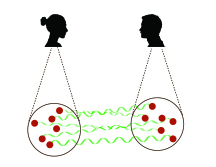The journal selected the paper for highlighting as an Editor's suggestion
The journal selected Nicole Yunger Halpern paper "Nonlinear Bell inequality for macroscopic measurements" for highlighting as an Editor's suggestion.
The quantum equivalent of seeing bacteria through everyday glasses
Entanglement—strong correlations that quantum particles can share— divides quantum physics from the everyday, or classical, world. Detecting entanglement in, for example, quantum computers and quantum networks is important: Only if nonclassical does a device have the potential to solve problems or to communicate information in ways impossible for today’s computers and telephones. Quantum systems are small, whereas classical systems are large. So conventional wisdom dictates that we can detect entanglement only if able to measure systems very precisely, similarly to how we can see bacteria only if given a microscope. This paper shows how to see bacteria through ordinary glasses, so to speak—how to detect entanglement amongst many particles by measuring only large-scale properties coarsely. The scheme works if the particles interact with each other in a limited fashion. Examples include detecting entanglement amongst photons (particles of light) by measuring the overall intensity of a beam of light. The photon proposal is testable in laboratories today; more- speculative applications include biochemistry and cosmology. This work challenges intuitions about the quantum-classical divide while helping us detect deviations from our everyday world.


